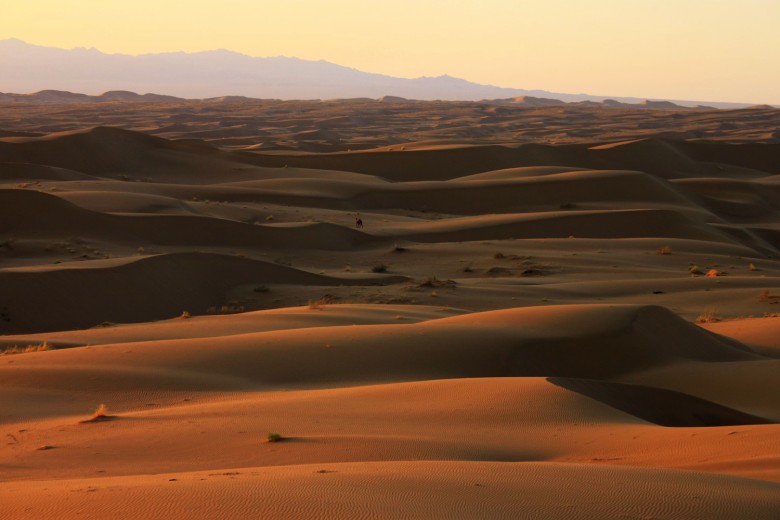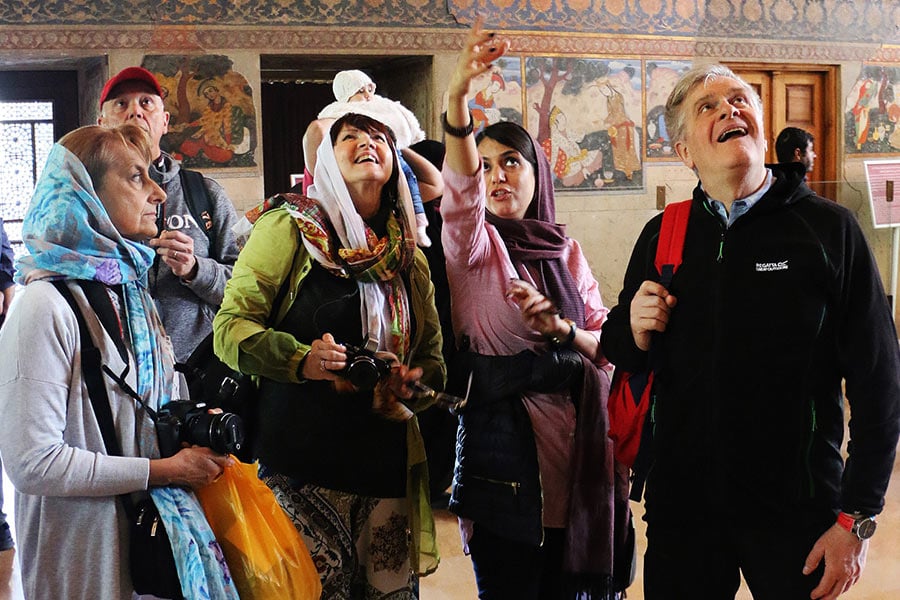Exploring the Deserts of Iran: A Comprehensive Travel Guide
Where Vast Golden Landscapes and Ancient Secrets Await

Discover the breathtaking deserts of Iran, where vast landscapes and historic treasures await adventurous travelers. This guide provides essential tips for navigating these arid regions, highlighting must-see attractions like the majestic dunes of Dasht-e Kavir and the ancient caravanserais of Dasht-e Lut.
Whether you’re a seasoned explorer or a first-time visitor, our comprehensive travel guide ensures a memorable and safe desert adventure. Explore the unique beauty and enduring culture of Iran’s deserts with confidence.
Contents
1. The Dasht-e Kavir

Dasht-e Kavir, Iran’s largest desert, spans the central plateau of Iran, covering an area of about 77,000 square kilometers. It is renowned for its salt marshes, mud-brick forts, and unique wildlife. The desert’s harsh climate and challenging terrain offer a fascinating glimpse into the adaptability of nature.
Location and Geography
Located in the northern part of the central Iranian plateau, Dasht-e Kavir is bounded by the Alborz mountain range in the north and extends southward towards the cities of Yazd and Isfahan. Its landscape features a mix of salt flats, sand, and rocky outcrops, creating a stark yet beautiful panorama.
Climate
The desert experiences extreme temperatures, with scorching summers and cold winters. Daytime temperatures can soar above 50°C (122°F) in summer, while winter nights may drop below freezing.
Attractions in Dasht-e Kavir

Salt Lake and Mud Cities
One of the key attractions in Dasht-e Kavir is the vast Salt Lake, an expansive area where the ground is covered with natural salt. Nearby, ancient mud cities such as Kashan offer a peek into historical architecture and traditional desert life. Visit the historical houses and bustling bazaars of Kashan for a cultural experience.
Wildlife and Vegetation
Despite the arid conditions, Dasht-e Kavir is home to a variety of wildlife, including the Persian onager, Asiatic cheetah, and numerous bird species. Sparse vegetation like tamarisk trees and shrubs provide a vital habitat for these creatures.
Adventure and Activities
For adventure seekers, Dasht-e Kavir offers exhilarating activities such as desert trekking, camel riding, and overnight camping under the stars. Experience the silence and vastness of the desert, which provides a perfect escape from the hustle and bustle of city life.
Planning Your Visit
Best Time to Visit
The ideal time to visit Dasht-e Kavir is during the cooler months from October to April, when the weather is more temperate and conducive to outdoor activities.
Travel Essentials
Prepare for your desert adventure by packing appropriate gear, including sun protection, comfortable walking shoes, and ample water. Always travel with a guide experienced in navigating the challenging desert terrain.
2. Lut Desert

The Lut Desert, also known as Dasht-e Lut, is recognized as one of the hottest places on Earth, with ground temperatures reaching as high as 70°C (158°F). Covering more than 51,000 square kilometers, it offers a stunning landscape of sand, rock, and scorched earth.
Location and Geography
Situated in southeastern Iran, the Lut Desert is framed by mountains that restrict moisture from reaching its interiors, creating its arid conditions. The desert is known for its towering sand dunes, some of the tallest in the world, and its mesmerizing yardangs—long ridges formed by wind erosion.
Climate
The climate in Lut Desert is characterized by extreme heat during the day and surprisingly cold temperatures at night. This dramatic temperature fluctuation is a hallmark of true desert environments.
Attractions in Lut Desert

Gandom Beryan Plateau
One of the most astonishing sites in the Lut Desert is the Gandom Beryan Plateau, a vast area covered in black lava. This plateau has recorded some of the highest ground temperatures on Earth, making it a site of scientific interest and a magnet for thrill-seeking tourists.
Yardangs and Sand Dunes
The desert is famous for its yardangs, which have been sculpted over thousands of years. These natural sculptures provide a stunning visual against the backdrop of expansive sand dunes, offering perfect opportunities for photography and exploration.
Star Gazing
With minimal light pollution, the Lut Desert is an ideal spot for stargazing. The clear desert skies allow for an unobstructed view of the Milky Way and countless stars, making it a magical experience for visitors.
Travel Tips for Lut Desert
When to Visit
The best time to visit the Lut Desert is between November and March, when the temperatures are more bearable. This period avoids the extreme summer heat, which can be dangerous for visitors.
Safety and Preparation
Due to the extreme conditions, it is crucial to prepare adequately for a trip to the Lut Desert. Essential items include high SPF sunscreen, a wide-brimmed hat, long sleeves, and plenty of water. It is strongly recommended to explore the desert with an experienced guide who can navigate its challenging terrain safely.
3. Maranjab Desert

Maranjab Desert is known for its soft sands, historical caravanserais, and the stunning Salt Lake. Its proximity to major cities like Tehran and Isfahan makes it a popular destination for both adventurers and history enthusiasts.
Location and Geography
Situated in the central part of Iran, near the city of Kashan, Maranjab offers easy access to the capital while feeling worlds away. The desert features rolling sand dunes, salt flats, and a diverse ecosystem that supports a variety of wildlife and vegetation.
Climate
Maranjab experiences a typical desert climate with hot days and cool nights. The best times to visit are during the spring and autumn months, when the temperature is more moderate and the natural beauty of the desert is at its peak.
Attractions in Maranjab Desert

Maranjab Caravanserai
Built in the 16th century during the Safavid era, the Maranjab Caravanserai served as a crucial stop on the Silk Road. Today, it stands as a testament to Iran’s rich history and is a highlight for visitors exploring the desert. Its well-preserved structure offers a glimpse into the past, where traders and travelers rested and replenished.
Salt Lake and Wonder Island
The Maranjab Salt Lake, with its floating ‘Wonder Island,’ is a phenomenal sight. The salt crusts create a reflective surface that beautifully mirrors the sky, while the island, surrounded by salt, appears as if it’s floating. This surreal landscape is perfect for photography and nature walks.
Flora and Fauna
Despite the harsh conditions, Maranjab is home to wildlife such as foxes, wolves, and various reptiles. The vegetation mainly consists of salt-tolerant plants like tamarisks, which thrive in the saline conditions of the desert.
Adventure Activities
Maranjab offers numerous activities for adventure seekers, including off-roading, camel riding, and sand skiing. Nighttime brings a new adventure with spectacular stargazing opportunities, thanks to the clear desert skies.
Planning Your Visit
Travel Essentials
When planning your trip to Maranjab, it’s important to be well-prepared. Bring sun protection, suitable desert attire, and plenty of water. Navigation can be tricky in the desert, so traveling with a guide from SURFIRAN is highly recommended to enhance your safety and overall experience.
4. Mesr Desert

Mesr is Persian for ‘Egypt,’ a name given by a local resident to this small oasis village, which stands as a symbol of beauty in the arid landscape. Located in the heart of Iran’s central desert, near the town of Khur and Biabanak, Mesr offers a perfect blend of cultural history and natural wonder.
Location and Geography
The Mesr Desert lies 420 kilometers away from Tehran and is accessible via the cities of Nain or Isfahan. This desert is celebrated for its dunes, which range in color from soft beige to golden yellow, shifting and shimmering under the desert sun.
Climate
Like most deserts, Mesr experiences extreme temperature variations between day and night. The best times to visit are in the cooler months from October to April, when the weather is ideal for exploring and camping under the stars.
Attractions in Mesr Desert

Sand Dunes
The undulating dunes of Mesr are a major draw for visitors, offering a picturesque setting for sandboarding, quad biking, or simply enjoying a peaceful walk. The ever-changing nature of these dunes makes each visit unique.
Mesr Village
At the heart of the desert lies Mesr village, where the hospitality of the locals provides a warm welcome. The village offers a glimpse into traditional desert life and culture, making it a pivotal part of the Mesr experience.
Stargazing
With clear, unpolluted skies, Mesr is an astronomer’s paradise. The lack of light pollution allows for spectacular views of the Milky Way and countless constellations, making it a perfect spot for nighttime photography and stargazing.
Adventure Activities
Whether it’s riding a camel through the expansive sands or experiencing the thrill of an off-road vehicle, Mesr offers plenty of adventure activities. For those seeking tranquility, the simple joy of watching a sunset over the dunes can be equally exhilarating.
Travel Tips for Mesr Desert
What to Bring
Essential items for a trip to Mesr include sunscreen, hats, sunglasses, and protective clothing. Given the remote location, it’s also wise to carry extra water and snacks.
Safety and Navigation
The desert environment can be challenging to navigate, and conditions can change rapidly. To ensure a safe and enjoyable experience, SURFIRAN recommends traveling with one of our experienced guides who are familiar with the desert terrain and its unique challenges.
5. Shahdad Desert

The Shahdad Desert is located on the edge of the Lut Desert, about 100 kilometers from the city of Kerman. Renowned for its “Kaluts” or yardangs, Shahdad offers some of the most surreal and dramatic desert landscapes in Iran.
Location and Geography
Situated in southeastern Iran, Shahdad is easily accessible from Kerman. The desert stretches over a large area, featuring an array of geological phenomena created by erosion, which sculpts the landscape into breathtaking formations.
Climate
Shahdad experiences extreme temperatures, typical of most desert environments. During the summer, temperatures can soar, making early morning or late afternoon the best times for exploration. The cooler months from October to March provide the most comfortable conditions for visitors.
Attractions in Shahdad Desert

The Kaluts
The highlight of any visit to Shahdad is the Kaluts. These natural towers and ridges are formed by wind erosion and stand as tall as skyscrapers, stretching out into the horizon. Exploring these formations feels like walking on another planet.
Nebka Dunes
Among the fascinating features of the Shahdad Desert are the Nebka dunes. These are sand dunes that have formed around vegetation, creating natural pots and adding a unique element to the desert’s biodiversity.
Ancient Water Reservoirs
Shahdad is also home to ancient water reservoirs, known locally as “qanats,” which are part of a sophisticated irrigation system dating back thousands of years. These qanats highlight the ingenuity of ancient civilizations in arid environments.
Adventure and Activities
Adventure seekers will find plenty to do in Shahdad. From hiking and photography to camping under the starlit sky, the desert landscape offers endless opportunities for exploration and adventure.
Planning Your Visit
Travel Essentials
When visiting Shahdad, it’s essential to be well-prepared with sunscreen, protective clothing, and plenty of water. The desert’s remote and rugged nature requires sturdy footwear and possibly a GPS device when venturing into less-traveled areas.
Safety and Navigation
Given the extreme and often unpredictable conditions in the desert, traveling with an experienced guide from SURFIRAN is highly recommended. Our guides ensure your safety and provide enriching information about the desert’s geography and history.
6. Varzaneh Desert

Located close to the ancient city of Isfahan, Varzaneh Desert offers a landscape characterized by stunning white sands—unusual for the typically golden dunes found elsewhere in Iran. This desert is not only a natural wonder but also a cultural treasure, providing insights into traditional desert living.
Location and Geography
Varzaneh is situated about 105 kilometers southeast of Isfahan, making it an accessible escape into nature. The desert’s expansive white dunes provide a stark contrast to the deep blue sky, creating a mesmerizing panorama.
Climate
The climate in Varzaneh is typical of desert regions, with hot days and cooler nights. Visiting between October and April is ideal, as the temperatures are more moderate, making exploration more comfortable.
Attractions in Varzaneh Desert

White Sand Dunes
The main attraction in Varzaneh is its beautiful white sand dunes. These dunes are perfect for a variety of activities, including sandboarding, camel trekking, and dune bashing in 4×4 vehicles. The soft sand provides a unique challenge and thrill for adventure enthusiasts.
Historical Sites
Varzaneh is also home to several historical attractions, such as ancient bridges, water mills, and the old town itself, which holds over 5,000 years of history. These sites offer a glimpse into the area’s rich past and architectural traditions.
Gavkhooni Wetland
Near the edge of the desert lies the Gavkhooni Wetland, a vital ecosystem for migratory birds and local wildlife. This natural reserve is excellent for bird watching and experiencing the biodiversity that thrives in this arid region.
Cultural Experiences
Experience the local culture by visiting Varzaneh during traditional festivals or by engaging with the community in guesthouses that showcase local hospitality and cuisine. These cultural experiences are a cornerstone of any visit to Varzaneh.
Travel Tips for Varzaneh Desert
What to Pack
Be sure to pack essentials like high SPF sunscreen, a hat, sunglasses, and water. Lightweight but protective clothing will shield you from the sun while keeping you cool.
Safety and Navigation
Due to the remote and expansive nature of the desert, navigating Varzaneh can be challenging. SURFIRAN strongly recommends visiting with a knowledgeable local guide who can ensure your safety and enhance your understanding of the desert’s natural and cultural landscapes.
8. Halvan Desert

The Halvan Desert is located in the southeastern part of Semnan province, offering a quiet retreat from the more frequented tourist paths. Known for its rugged terrain and rich biodiversity, Halvan provides an authentic desert experience with its mix of sandy expanses and rocky outcrops.
Location and Geography
Situated near the towns of Damghan and Semnan, Halvan is accessible yet isolated enough to preserve its untouched beauty. The desert landscape is interspersed with salt flats, sand dunes, and mountainous areas, providing diverse scenery for explorers.
Climate
Halvan features the stark climatic contrasts typical of desert environments, with hot days and cool nights. The best times to visit are during spring and autumn when the weather is mild and conducive to outdoor activities.
Attractions in Halvan Desert

Natural Features
Explore the varied topography of the Halvan Desert, from its soft sand dunes to rugged salt flats. Each element of the terrain offers different challenges and pleasures, whether you’re into photography, hiking, or simply enjoying the silence of the desert.
Flora and Fauna
Despite the arid conditions, the Halvan Desert hosts a variety of life. Adapted to the harsh environment, species such as the Persian gazelle, desert foxes, and numerous bird species find refuge here. The sparse vegetation, including tamarisk and saxaul trees, adds to the desert’s mystique.
Historical Significance
The area around Halvan is steeped in history, with ancient caravanserais and trade routes that once buzzed with activity. These historical sites provide a fascinating glimpse into the life of travelers and traders who navigated these arid lands centuries ago.
Adventure Activities
Halvan is perfect for those seeking solitude and adventure. Activities like star gazing, overnight camping, and guided desert treks can be arranged. The clear night skies offer incredible opportunities for astronomy enthusiasts.
Planning Your Visit
What to Bring
For a trip to the Halvan Desert, it is crucial to be well-prepared. Essential items include robust hiking boots, sun protection, and navigation tools. Due to the remote nature of the desert, bring extra water and food supplies.
Safety and Navigation
Navigating the Halvan Desert requires caution due to its unmarked terrain and potential for rapid weather changes. Traveling with a guide from SURFIRAN not only ensures your safety but also enriches your experience with expert knowledge of the area.
Book Services, Pay Online
Conclusion
Experiencing new adventures is always thrilling. Deserts, with their mystery and untouched beauty, hold a special appeal among travel destinations. If you take a look at the map of Iran, you can appreciate the vastness and diversity of its deserts. In this article, we have introduced you to the best deserts in Iran. Which of these deserts have you explored? We would be delighted to hear about your experiences and share them with our readers.
Read More















I want to know about the tours (days)and the package details per person.
Thanks for your request. Kindly please contact via email. contact@surfiran.com